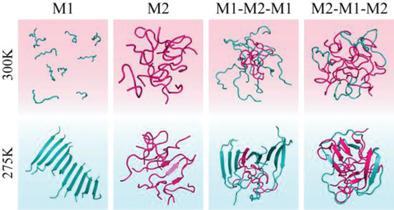Our official English website, www.x-mol.net, welcomes your feedback! (Note: you will need to create a separate account there.)
Molecular Insights into the Self-Assembly of Block Copolymer Suckerin Polypeptides into Nanoconfined β-Sheets
Small ( IF 13.3 ) Pub Date : 2022-07-28 , DOI: 10.1002/smll.202202642 Yuying Liu 1 , Ying Wang 1 , Chaohui Tong 1 , Guanghong Wei 2 , Feng Ding 3 , Yunxiang Sun 1, 2, 3
Small ( IF 13.3 ) Pub Date : 2022-07-28 , DOI: 10.1002/smll.202202642 Yuying Liu 1 , Ying Wang 1 , Chaohui Tong 1 , Guanghong Wei 2 , Feng Ding 3 , Yunxiang Sun 1, 2, 3
Affiliation

|
Suckerin in squid sucker ring teeth is a block-copolymer peptide comprised of two repeating modules—the alanine and histidine-rich M1 and the glycine-rich M2. Suckerin self-assemblies display excellent thermo-plasticity and pH-responsive properties, along with the high biocompatibility, biodegradability, and sustainability. However, the self-assembly mechanism and the detailed role of each module are still elusive, limiting the capability of applying and manipulating such biomaterials. Here, the self-assembly dynamics of the two modules and two minimalist suckerin-mimetic block-copolymers, M1-M2-M1 and M2-M1-M2, in silico is investigated. The simulation results demonstrate that M2 has a stronger self-association but weaker β-sheet propensities than M1. The high self-assembly propensity of M2 allows the minimalist block-copolymer peptides to coalesce with microphase separation, enabling the formation of nanoconfined β-sheets in the matrix formed by M1–M2 contacts. Since these glycine-rich fragments with scatted hydrophobic and aromatic residues are building blocks of many other block-copolymer peptides, the study suggests that these modules function as the “molecular glue” in addition to the flexible linker or spacer to drive the self-assembly and microphase separation. The uncovered molecular insights may help understand the structure and function of suckerin and also aid in the design of functional block-copolymer peptides for nanotechnology and biomedicine applications.
中文翻译:

嵌段共聚物 Suckerin 多肽自组装成纳米限制 β-片层的分子洞察
鱿鱼吸盘环齿中的吸盘蛋白是一种嵌段共聚物肽,由两个重复模块组成:富含丙氨酸和组氨酸的 M1 以及富含甘氨酸的 M2。Suckerin 自组装体表现出优异的热塑性和 pH 响应特性,以及高生物相容性、生物降解性和可持续性。然而,自组装机制和每个模块的详细作用仍然难以捉摸,限制了应用和操纵此类生物材料的能力。在这里,研究了两个模块和两种极简模拟吸盘嵌段共聚物 M1-M2-M1 和 M2-M1-M2 的计算机自组装动力学。模拟结果表明,M2 比 M1 具有更强的自缔合性,但 β 折叠倾向更弱。M2 的高自组装倾向使得极简嵌段共聚物肽能够通过微相分离聚结,从而能够在 M1-M2 接触形成的基质中形成纳米限制的 β-折叠。由于这些富含甘氨酸的片段具有分散的疏水性和芳香族残基,是许多其他嵌段共聚物肽的构建模块,因此研究表明,除了柔性接头或间隔基之外,这些模块还充当“分子胶”来驱动自组装和微相分离。未发现的分子见解可能有助于理解吸盘蛋白的结构和功能,也有助于设计用于纳米技术和生物医学应用的功能性嵌段共聚物肽。
更新日期:2022-07-28
中文翻译:

嵌段共聚物 Suckerin 多肽自组装成纳米限制 β-片层的分子洞察
鱿鱼吸盘环齿中的吸盘蛋白是一种嵌段共聚物肽,由两个重复模块组成:富含丙氨酸和组氨酸的 M1 以及富含甘氨酸的 M2。Suckerin 自组装体表现出优异的热塑性和 pH 响应特性,以及高生物相容性、生物降解性和可持续性。然而,自组装机制和每个模块的详细作用仍然难以捉摸,限制了应用和操纵此类生物材料的能力。在这里,研究了两个模块和两种极简模拟吸盘嵌段共聚物 M1-M2-M1 和 M2-M1-M2 的计算机自组装动力学。模拟结果表明,M2 比 M1 具有更强的自缔合性,但 β 折叠倾向更弱。M2 的高自组装倾向使得极简嵌段共聚物肽能够通过微相分离聚结,从而能够在 M1-M2 接触形成的基质中形成纳米限制的 β-折叠。由于这些富含甘氨酸的片段具有分散的疏水性和芳香族残基,是许多其他嵌段共聚物肽的构建模块,因此研究表明,除了柔性接头或间隔基之外,这些模块还充当“分子胶”来驱动自组装和微相分离。未发现的分子见解可能有助于理解吸盘蛋白的结构和功能,也有助于设计用于纳米技术和生物医学应用的功能性嵌段共聚物肽。


























 京公网安备 11010802027423号
京公网安备 11010802027423号